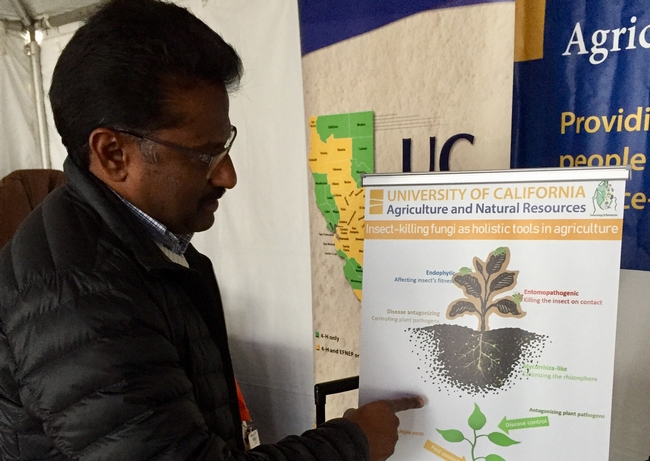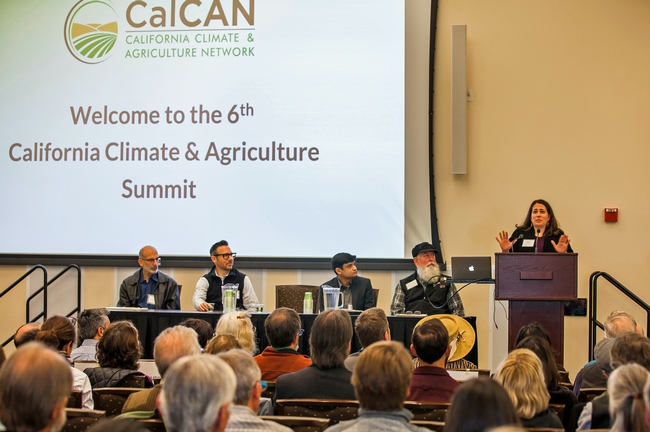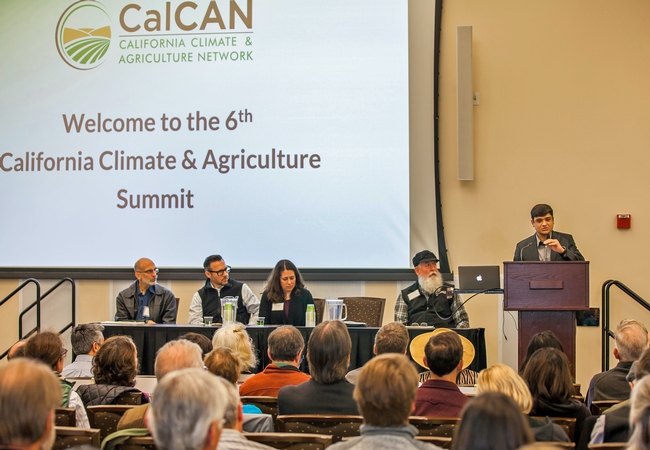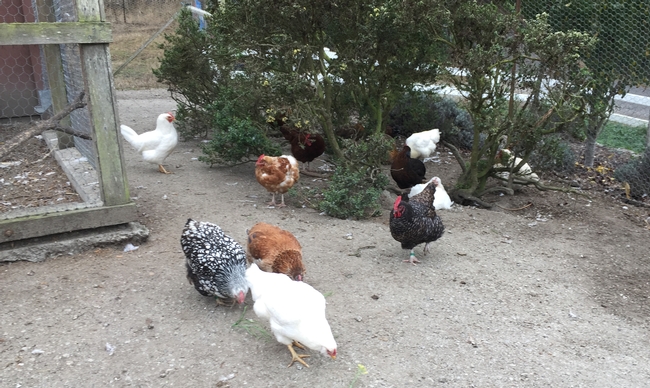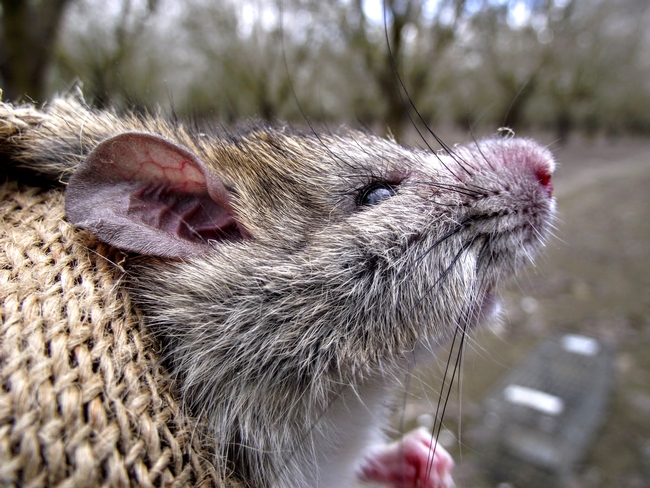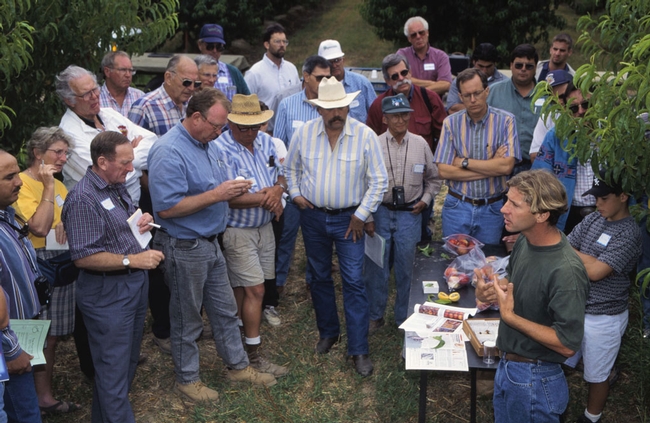Posts Tagged: Tapan Pathak
ANR in the news March 1-11
Western Innovator: Putting biologicals to work
(Capital Press) Padma Nagappan, March 11
Early in life, Surendra Dara decided that no matter which field he chose, he needed to make an impact on it. Always interested in science, he chose agriculture and specialized in entomology.
“It attracted me because it dealt with arthropods and there are a lot of physiological similarities to the human world,” Dara said. “It was also critical for growing food and feeding humans.”
Dara is now an entomopathologist with the University of California's Division of Agriculture and Natural Resources in San Luis Obispo, and has an established reputation for exploring innovative options to control pests using microbials as biological controls, and showing growers how they can also help with plant growth, drought resistance and fighting diseases.
Group linked to Ocasio-Cortez seeks ag input after Green New Deal backlash
(Politico) Helena Bottemiller Evich, March 11
After watching that drama unfold, Frank Mitloehner, a leading scientist on agricultural emissions at the University of California, Davis, was thrilled when two outreach staff affiliated with AOC's network reached out to set up a call to discuss the potential for climate mitigation efforts in agriculture. The call, held earlier this month, lasted more than an hour, Mitloehner said.
“I was very glad to inform of what I know, and they were very receptive to it,” Mitloehner said on Agri-Talk last week. During the segment, he urged agricultural producers to not dismiss the left-wing climate effort.
Sudden surge in an unusual crime in Fresno County: Goat theft
(LA Times) Hannah Fry, March 11, 2019
…Picquette's two sons have been raising goats for the last five years as a 4-H project. Losing their animals has been especially hard for the boys, Picquette said, adding that they had planned to use money won during competitions to pay for college.
“They feel very violated. They don't understand how somebody could just come and take something they worked so hard for,” she said. “The bond we have with the goats is incredible. I'm just heartbroken. I don't know if they're scared or hungry. … They've always been treated so well.”
https://www.latimes.com/local/lanow/la-me-ln-fresno-goat-theft-20190311-story.html
California's ambitious plan to stop deadly wildfires may not be enough, experts say
(SF Chronicle) Kurtis Alexander, March 9
… “It's not fair to say that fuel treatments won't do any good,” said Max Moritz, a UC Cooperative Extension wildfire specialist at UC Santa Barbara. “It may provide some protection in some places. But most of us studying this agree that you can't just do this and (expect to) make much headway.”
The plan by the California Department of Forestry and Fire Protection, or Cal Fire, comes at the request of Gov. Gavin Newsom. On his second day in office, Newsom asked the agency to develop a proposal to address the increasingly destructive fire seasons that have rattled the state and are expected to worsen with climate change.
…In the meantime, many researchers say the most effective approach to fire protection is not in the forests, but in communities. They recommend making homes more resistant to fire with hardier construction materials, and clearing the vegetation around them.
“You have to address the home vulnerabilities themselves,” said Moritz at UC Santa Barbara. “If you don't, you're just not going to make a lot of progress on fire.”
After more than 140 years, a massive fig tree gracing the plaza where Los Angeles was founded collapses
(LA Times) Matthew Ormseth, March 9
… The four figs were planted at El Pueblo by agriculturalist and City Councilman Elijah Hook Workman, KCET reported in 2013. The Ficus macrophylla was brought from Australia to Southern California in the 1860s and 1870s, probably to provide shade and ornamentation, said Donald Hodel, a horticulture advisor for the University of California's Cooperative Extension.
Hodel described the Moreton Bay fig as a commanding breed of tree with an enveloping canopy that threw plenty of shade.
His reasons for admiring the Moreton Bay fig: “Their grandeur; their size — they have an imposing habit; their root structure is incredible; the spreading nature of their branches.”
Hodel said he last saw the El Pueblo figs about six years ago.
“I wasn't too impressed by their health or their size, considering they're 140-something years old,” he said.
https://www.latimes.com/local/lanow/la-me-pueblo-tree-falls-20190309-story.html
California's 2018 Was the Worst Ever Recorded for Wildfires
(Gizmodo) Tom McKay, March 9
University of California, Santa Barbara UC Cooperative Extension wildfire researcher Max Moritiz told the Chronicle, “It's not fair to say that fuel treatments won't do any good. It may provide some protection in some places. But most of us studying this agree that you can't just do this and (expect to) make much headway.”
https://earther.gizmodo.com/californias-2018-was-the-worst-ever-recorded-for-wildfi-1833180368
4-H leader who taught lost Benbow girls outdoor skills being flown to Washington, DC for recognition
Kym Kemp, March 7
When Leia Carrico, age 8, and her sister, Caroline, age 5, disappeared into the woods around their home near Benbow on March 1, the whole nation held its breath for the next 44 hours until they were found. But, though their 4-H leaders were worried, too, they say they also knew the girls had something many other children don't–they had survival skills from a class taught by their Outdoor Adventures 4-H project leader, Justin Lehnert.
Lehnert is being honored in Washington, DC, on Tuesday for his role in teaching Leia and Caroline outdoor skills.
Researchers highlight plan to eat healthy on a budget
(Consumer Affairs) Kristen Dalli, March 7
Following a healthy diet can come with a hefty price tag, but a team of researchers has outlined a way for consumers to stick to a healthy diet -- and also stick to their budgets.
According to the team, consumers -- and their families -- can have healthy meals if they focus on buying items in bulk and planning meals in advance.
“This study determines the likelihood that families living in low-income households could create meals that meet the USDA dietary guidelines presented in MyPlate nutrition education materials,” said researcher Karen M. Jetter, PhD. “In addition to food cost, the other factors considered were access to stores, time for meal preparation, and whether the menus included culturally appropriate foods.”
Healthy eating is possible on a limited budget, study shows
Study: Eating healthy on a budget is possible
https://www.upi.com/Study-Eating-healthy-on-a-budget-is-possible/9951551904010/
Eating Healthy Is Possible on a Small Budget, Says Study
https://www.askmen.com/news/sports/eating-healthy-is-possible-on-a-small-budget-says-study.html
Sorry, Alexandria Ocasio-Cortez, but “farting cows” aren't the problem
(New Food Economy) Sam Bloch, March 7
…As it turns out, neither side was accurate. Republicans are likely to continue linking Green New Deal priorities to a supposed hamburger ban. But if you don't hear about cow farts anymore from AOC, it may not be because of GOP criticism. Frank Mitloehner, an animal scientist and air quality specialist at the University of California, Davis, insists cattle flatulence isn't the problem it's made out to be, and says he helped set the record straight.
Here's what seems to have happened. On February 4, shortly before Ocasio-Cortez announced the Green New Deal, she was speaking to school children in Queens, New York. When one asked how they could “combat” climate change, Ocasio-Cortez offered two practical options—stop using disposable razors, and skip meat and dairy for one meal.
Mitloehner tweeted at her.
“Dear @AOC: we all try to help the climate,” he wrote. “However, the two options you offered have low impacts compared to the 800lb gorilla, which is to reduce fossil fuel use. About ? of greenhouse gas emissions in the US stem from transport and energy prod&use. Meat/milk = 4 % of total GHG,” referring to findings in a recent EPA report.
… “I give her team a lot of credit for reaching out,” Mitloehner says. “If we really are serious about making a difference in carbon emissions, you cannot do this without agriculture involved.”
California supplies a quarter of the world's sunflower seeds
(Capital Press) Padma Nagappan, March 7
…Khaled Bali is a University of California Department of Agriculture and Natural Resources statewide water and irrigation specialist who has been working since 2016 on a four-year trial on sunflower varieties.
He was asked by the University of Georgia to help ascertain which varieties were drought resistant. He chose to conduct his trial in the low desert region of the Imperial Valley, since it gets little rain during the growing season between February when it's planted, and June when it's harvested. This would make it easier to control and measure the actual water applied to the crop varieties.
“We're looking at 285 varieties of sunflowers, to see which ones do well under stress,” Bali said. He has tested different plantings each growing season for the past three years, and will finish the trial this year.
https://plantingseedsblog.cdfa.ca.gov/wordpress/?p=17375
Livestream coverage of fire protection panel discussion in Nevada City
(Sierra Sun) March 7
…Following the films, the community is invited to join an ongoing conversation around the new reality of living with fire in the wildland urban interface. Panelists represent a diverse cross-section of the wildfire prevention community including: Cal Fire, Fire Safe Council of Nevada County, Nevada County Office of Emergency Services, Nevada County Resource Conservation District, Pacific Gas and Electric Company, Tahoe National Forest and University of California Cooperative Extension. The panel discussion will be moderated by YubaNet Co-founder Pascale Fusshoeller. [Kate Wilkin, UCCE fire advisor, participates on the panel in the last hour of the video.]
Bees, blooms off to slow start
(Western Farm Press) Logan Hawkes, March 6
…This year, almond bloom started around a normal time, with some early varieties showing a few open flowers in the first week of February,” reported Franz Niederholzer, UCCE farm advisor for Colusa, Sutter, and Yuba Counties. “For most of the month bloom progressed very slowly,”
By the middle of February, he says, “bloom for Nonpareil was at least two weeks behind, and bee hours were limited until the last week of the month. Last year, between Feb 1-20, we accumulated 130 bee hours of good honey bee flying weather [55 F., no rain, and wind less than 10 mph]. For the same interval this year, we had around 10 hours and only six of those occurred with open flowers in the orchard.”
On the positive side of the slow start, Niederholzer says, the colder weather tends to suppress activity of key bloom diseases such as blossom brown rot and anthracnose. “However, cold weather at bloom was conducive to blossom blast (pseudomonas) bacteria, and some growers were considering adding materials to their normal bloom fungicides with bactericide activity.”
https://www.farmprogress.com/tree-nuts/bees-blooms-slow-start
Wet winter aids groundwater replenishment
(Ag Alert) Christine Souza, March 6
… Helen Dahlke, a hydrology expert and professor with the University of California, Davis, Department of Land, Air and Water Resources, has been working with farmers, studying on-farm groundwater recharge locations and suitability for various crops.
"In many regions, we can definitely do more actively recharging our groundwater aquifers," said Dahlke, who currently has trials on alfalfa at the UC Kearney Agricultural Center. "It really depends on what region, how much surface water is available for recharge, what kind of sediment structure or hydrogeology we have underneath and whether it's suited for conveying large amounts quickly."
Despite abundant precipitation in recent weeks, she said the timing is not the best for studying impact of recharge on certain crops.
"We prefer on-farm recharge to happen in January and February, just because that is considered the dormancy season for most crops," Dahlke said. "With almond trees already blooming, often there is a greater risk of applying water on those crops."
She said recent precipitation has helped groundwater recharge overall, but there is "very little way of estimating how much it is helping."
http://www.agalert.com/story/?id=12797
Drip irrigation improves yields of Imperial sugar beets
(Ag Alert) Padma Nagappan, March 6
Halfway through a two-year irrigation trial to test furrow irrigation versus drip on sugar beet in California's Imperial Valley, Ali Montazar is looking for ways to boost yields with as little water consumption as possible in a region where furrow irrigation is the common practice.
Montazar, irrigation and water management advisor with the University of California department of agriculture and natural resources (UCANR) in Imperial County, is comparing and evaluating sugar beets for crop water use, sugar percentage, and yield, using both furrow and drip, since growers are now thinking of switching to subsurface drip.
Preliminary results from year one of the trial show that yield and crop water use are better with drip. Yield was 21 percent higher, and water use was a few points lower.
http://www.agalert.com/story/?id=12782
NFU says “No” to Green New Deal
(DTN) Jerry Hagstrom and Chris Clayton, March 6
Frank Mitloehner, an animal-science professor and air-quality Extension specialist at the University of California-Davis, reached out to Ocasio-Cortez's team about agriculture and the Green New Deal after seeing social media posts late last month about “farting cows” that drew a great deal of attention.
“I appreciate her interest in climate-change mitigation, but the 800-pound gorilla is the use of fossil fuels, and I told her that even the notion of cow flatulence makes this whole thing sound silly, and that's not what we need this discussion to be,” Mitloehner told DTN in an interview.
From Farting Cows to More Beans; Anti-Livestock Claims Fall Short
(AgriTalk) Jennifer Shike, March 5
The EAT-Lancet Commission on Food, Planet, Health is backpedaling as industry leaders and scientists poke holes in its “planetary diet” released in mid-January that is supposed to improve human health and planet health.
Air Quality Extension Expert Frank Mitloehner of the University of California Davis joined Chip Flory on AgriTalk Monday to discuss EAT-Lancet and Green New Deal in more depth.
4-H instructor who taught NorCal sisters how to survive in wilderness speaks out
(ABC7) Dion Lim, March 4
ABC7 News spoke exclusively to the 4-H instructor who taught two young girls the life-saving skills they needed to survive a weekend lost in the woods.
… Their mom, Misty Carrico, says she's not sure her daughters would have survived, if not for their 4-H program.
"The group leader Justin has taught them fire making skills and wilderness survival skills."
Justin Lehnert, the girls' 4-H leader, said, "I'm ecstatic that they did the job that they did. They're very strong girls and they stayed calm."
… Nine-year-old Caroline Gelormini has been a member of the San Bruno-South San Francisco 4-H Program for five years. Thanks to 4-H, she feels like she'd have a shot at surviving in the woods too.
Ocasio-Cortez Seeks Ag Data on Green New Deal
(Drovers) John Herath, March 4
When freshman congresswoman Alexandria Ocasio-Cortez released her Green New Deal plan, social media lit up with talk of her plan's mentions of “farting cows.” That drew the attention of agriculture's preeminent expert on air quality, Dr. Frank Mitloehner of the University of California at Davis, who tweeted back at the congresswoman.
“I don't know whether my tweet was the reason, but a few hours after I tweeted her, all mentioning of cow flatulence were taken off the web pages and of all social media outlets and was never to be heard again,” Mitloehner told Chip Flory on the AgriTalk Radio Show Monday.
https://www.drovers.com/article/ocasio-cortez-seeks-ag-data-green-new-deal
2 missing Humboldt County girls found — ‘absolute miracle
(SF Chronicle) Michael Cabanatuan, March 3
…Little additional information was available on how the girls went missing or how they survived, but Honsal said they had been trained in outdoors survival as members of a 4-H program.
https://www.sfchronicle.com/news/article/Absolute-miracle-as-missing-Humboldt-County-13659375.php
Organic farm east of Denair does its part on climate change. It's getting an award
(Modesto Bee) John Holland, March 2
…The family won in the farmer/rancher category of the Climate Leadership Awards. The others:
- Researcher: Tapan Pathak of the University of California Cooperative Extension in Merced, who helps farmers adapt to climate change.
- Policymaker: Ken Alex, who was director of former Gov. Jerry Brown's Office of Planning and Research
- Legislative staff: Brett Williams, office of Assemblywoman Jacqui Irwin, D-Thousand Oaks
- Agricultural professional: Ruth Dalquist-Willard, UC Cooperative Extension, Fresno
https://www.modbee.com/news/article226956529.html
Eructation Inflation: Greenhouse Gas Emissions of Livestock
(Science for the Rest of Us) March 1
Put your nerd hat on -- we cover a lot of ground in this fast-paced discussion with Dr. Frank Mitloehner of the University of California-Davis about the greenhouse gas emissions associated with the meat and dairy we consume. We consider how livestock emissions compare to other sectors of the US and global economies, the carbon footprint of vegetarian diets and what is the most effective way to reduce individual carbon emissions.
Keeping the Carbon Footprint of Livestock in Perspective
(AgNet West) Brian German, March 1
…“It is irresponsible and it's misguiding the public to believe that the true sources of pollution are downplayed, and the impacts of animal agriculture are grossly inflated,” said Dr. Frank Mitloehner, Professor and Air Quality Specialist in Cooperative Extension in the Department of Animal Science at the University of California, Davis.
Two UCCE agricultural climate leaders recognized at the 6th California Climate & Agriculture Summit
Five California leaders, including two UC Cooperative Extension scientists, were recognized for their contributions to the field of agriculture and climate change at the California Climate & Agriculture Summit at UC Davis on March 5, 2019, said a news release issued by California Climate & Agriculture Network (CalCAN).
The summit was organized by CalCAN and brought together some of the state's foremost experts in agriculture — including farmers, agriculture professionals, researchers, advocates and policymakers — to grapple with the challenges of climate change and share knowledge about the opportunities facing the industry.
At the summit, CalCAN presented the leadership award for agricultural professional to Ruth Dahlquist-Willard, UC Cooperative Extension small farms advisor in Fresno and Tulare counties.
Dahlquist-Willard helps keep small-scale, diversified farmers in business by providing support with marketing, regulatory compliance, processing of value-added products, water and energy efficiency, and integrated pest management. She has been a driving force behind increasing access by Hmong farmers in the Fresno area to California's State Water Efficiency and Enhancement Program (SWEEP). Dahlquist-Willard has promoted the program, provided thousands of hours of one-to-one, culturally-relevant support to farmers on grant applications, and assisted with project design and installation. The farmers she has supported are now benefiting from water, energy and financial savings.
"There are large environmental problems to solve in the Central Valley, and it's time for a different conversation around farming there," Dahlquist-Willard said. "I feel that there needs to be a conversation in the middle to solve problems rather than a conflict-based approach."
The leadership award for researcher was presented to Tapan Pathak, UC Cooperative Extension specialist for climate adaptation in agriculture, based at UC Merced.
Pathak is the chair of the UC Cooperative Extension Climate Change Adaptation Workgroup, which brings together scientists across the UC system to collaborate on research and extension projects related to climate change adaptation in California agriculture. Pathak is the lead author on an important and timely paper that was published in 2018 in the journal Agronomy. It synthesizes the impacts of climate change on California agriculture and offers directions for future research and implementation.
"We need more facilitated dialog with policy researchers and scientists on the science of climate change, and the implications of not taking action," Pathak said. "Given the scale of California agriculture and the pressure of climate change impacts, we need even more substantial funding for incentives for farmers and for research and tools, and we must integrate growers from the beginning of the process."
The other CalCAN leadership awards were presented to the following:
Leadership Award for policymaker: Ken Alex, former Director of Governor Brown's Office of Planning & Research
Leadership Award for farmer/rancher: Ward and Rosie Burroughs, Burroughs Family Farm (Denair, CA)
Leadership award for legislative staff: Brett Williams, Office of Assemblymember Jacqui Irwin
March news clips
Unprecedented Study Discovers what Urban Coyotes Really Eat
(Care2) Laura Goldman, March 30
Hiking boots, avocados, candy wrappers and fast-food containers. These aren't a few of my favorite things, but they are some of the items found inside the stomachs of dead urban coyotes in Los Angeles and Orange counties.
…Since the study began over a year ago, the researchers, led by Dr. Niamh Quinn, the human-wildlife interactions advisor for the University of California Cooperative Extension, have discovered that cats make up only about eight percent of a coyote's diet.
https://www.care2.com/causes/unprecedented-study-discovers-what-urban-coyotes-really-eat.html
Red blotch grape virus confirmed in Calaveras
(Calaveras Enterprise) Jason Cowan, March 29
Red blotch virus, a DNA infection that decreases a grape's sugar levels on the vine, has been confirmed in Calaveras County, officials said last week.
After confirmed cases of the virus were located recently in El Dorado and Amador county vineyards, University of California Cooperative Extension Farm Adviser Lynn Wunderlich saw what she thought were symptoms of the virus in Calaveras and recommended farmers test for red blotch.
The results came back positive.
http://www.calaverasenterprise.com/news/article_4ebae972-33aa-11e8-ab5c-cb61df3e8deb.html
Raising chickens at home? Get their eggs tested for free
(Daily Democrat) ANR News release
Californians who raise poultry outdoors are invited to get their eggs tested for contaminants.
To find out if harmful substances on the ground that are eaten by hens get passed along in the eggs they lay, Maurice Pitesky, UC Cooperative Extension poultry specialist at the UC Davis School of Veterinary Medicine, is providing free egg testing.
“We're trying to understand the connection between the environment that backyard poultry are raised in and the eggs they are producing,” Pitesky said.
http://www.dailydemocrat.com/article/NI/20180329/FEATURES/180329815
Here's what trade tariffs could mean in Merced County, where nuts are big business
(Merced Sun-Star) Thaddeus Miller, March 28
China has threatened retaliatory tariffs on a select group of exports from the U.S. following President Donald Trump's plan to impose tariffs on steel and aluminum imports.
China's tariffs would first hit U.S. products such as avocados and nuts, with 15 percent duties. Beijing, if officials deemed it worthwhile, could also place 25 percent tariffs on American-made goods such as pork and aluminum.
…"It doesn't really matter which one it is, whether it's alfalfa, almonds or wherever it may go," said David Doll, a farm adviser with the Merced County UC Cooperative Extension. "They're as much political as they are anything else."
Nuts are big business in Merced County, where almonds are the second largest commodity at $578.5 million, according to the 2016 Merced County Crop Report, the most recent available. Almonds, pecans and pistachios bring in tens of millions of dollars more.
Out of every dollar made on a farm in the Central San Joaquin Valley, half pays for salaries and 40 cents goes to pay for supplies, Doll said, citing UC cooperative studies.
"Farms are businesses, and if they aren't profitable they're not going to stay in business," Doll said.
http://www.mercedsunstar.com/news/business/agriculture/article207155554.html
A film you may want your favorite doctor, trainer, chef and lawmaker to see
(Farm Week Now) Mike Orso, March 28
In the documentary “Food Evolution,” scientist Alison Van Eenennaam captures a smartphone selfie image of her with Bill Nye, the “Science Guy,” following a spirited forum in New York City on genetically modified organisms or GMOs. That was three years ago. Now, Van Eenennaam has young people coming up to her asking for selfies.
“If we can engage this next generation with critical thinking skills and trying to get to the bottom of what actually is true, I think we will have accomplished our job,” said Van Eenennaam, a University of California-Davis Extension specialist and one of several scientists featured in the film.
http://farmweeknow.com/story-film-may-want-favorite-doctor-trainer-chef-lawmaker-1-173628
Scientists say regulation stifles many new biotech traits
(Agri-Pulse) Jim Weber, March 28
Federal regulation of agricultural biotechnology needs to be based on risk and not on process, a wide range of scientists and food industry executives agreed at the Agri-PulseAg and Food Policy Summit. Coincidentally, a similar message was delivered a day later by a Council on Agricultural Science and Technology (CAST) task force.
“Scientists have been screaming that for 30 years,” said Alison Van Eenennaam, a cooperative extension specialist in animal genomics and biotechnology at the University of California-Davis. “That's where regulation should be.”
…Although the USDA, universities and small businesses have developed dozens of GE crops – with improved traits ranging from healthier and less allergenic to safer and more environmentally sustainable – and carried many through safety and pre-market testing, almost all have been denied commercial release mainly because of U.S. regulatory obstacles,” according to the CAST task force, led by Alan McHughen, who chairs the Department of Botany and Plant Sciences at California-Riverside.
https://www.agri-pulse.com/articles/10764-scientists-say-regulation-stifles-many-new-biotech-traits
If China Strikes Back On Tariffs, California Tree Nut Exports Could Take A Hit
(CapRadio) Julia Mitric, March 27
California agriculture could find itself caught in the middle of the U.S. — China trade dispute.
After President Trump ordered a 25 percent tariff on imported steel and a 10 percent tariff on imported aluminum last week, China hit back, announcing it may impose a 15 percent tariff on agricultural exports from the U.S.
The U.S. faces competitors for every agricultural product it exports. California wines, for example, compete with wines from New Zealand and Chile. If China hits the U.S. with a 15 percent tariff on wine, that's a problem, explains Dan Sumner, Director of the University of California Agricultural Issues Center.
"We may think California wine is special, but not everybody does,” Sumner said. "And if it's 15 percent more expensive than it used to be because of the tariff, there'll be a substantial reduction in how much gets sold in China."
State senator to honor UC 4-H program
(Morning Ag Clips)
California State Senator Ben Hueso will honor California and Baja California 4-H with a resolution in the State Senate at 2 p.m. April 2 to recognize the cross-border team that established a 4-H Club in Mexicali, Baja Mexico, in January 2017.
Last year, UC ANR Vice President Glenda Humiston signed a memorandum of understanding with the Baja California Secretary of Agriculture Development, Manuel Vallodolid Seamanduras, to offer UC's 4-H expertise to youth south of the border. The agreement increases the academic, scientific, technological and cultural cooperation that are part of UC President Janet Napolitano's Mexico Initiative.
https://www.morningagclips.com/state-senator-to-honor-uc-4-h-program/
Building an IPM Program to Fight Fruit Flies
(Growing Produce) David Eddy, March 26
When faced with spotted wing drosophila (SWD), it's critical for growers to keep in mind this is almost certainly unlike any pest they have dealt with before. That's because it's one of two species — out of a potential 1,500-plus — that feeds on healthy, not rotting, fruit.
That's certainly not the end of growers' difficulties with SWD, says Jhalendra Rijal, University of California Cooperative Extension Area IPM Advisor, Northern San Joaquin Valley. It's tricky because vinegar flies — the tiny flies often found circling above fruit bowls on kitchen tables — are so ubiquitous. Even the oh-so-common name, “fruit flies,” indicates the pests' omnipresence.
http://www.growingproduce.com/fruits/building-ipm-program-fight-fruit-flies/
Stallion Springs 4-H Swine Group visits local swine breeder
(Tehachapi News) Olivia Loyd, March 24
Tim Sturm, owner and operator of California Swine Services, farrowed approximately 600 piglets this year which will be shown all over California by 4-H and FFA members who take them to fairs and jackpot shows.
Sturm, who has a passion for teaching today's youth about raising swine, allowed the members of the Stallion Springs 4-H swine group to come to his facility on March 17 to learn to process one-day-old piglets. The kids learned to ear notch, dock tails, administer shots and clip needle teeth. Members learned why these processes are necessary, how to do them cleanly and correctly, and last were actually able take part in the process. They also learned valuable information about pig breeding and husbandry.
World Water Day
(KCAA) Water Zone, March 22
For World Water Day, Glenda Humiston discusses UC water research and what UC is doing to help ensure farmers and other Californians and the environment get the water they need. She also explains the Farm Bill. Humiston is introduced around the 30 min mark.
http://podcasts.kcaastreaming.com/water/ http://youtu.be/hN5pxvVI42A?a
Small Farms Must Include Marketing
(Cal Ag Today) Jessica Theisman, March 22
Mark Gaskell is with the University of California cooperative extension as a small farm and Specialty Crop Advisor for San Luis Obispo County. Gaskell recently told California Ag Today about his work with growers and small farms in the county since 1995.
“Part of my job has to do with applied research and educational programs, and this case related to keeping small farms viable and successful,” Gaskell said. “These activities include troubleshooting problems, helping growers develop new crops and develop new market opportunities that make them more competitive.”
https://californiaagtoday.com/small-farms-must-include-marketing/
How Biocontrols Fit into a Traditional Pest Control Program
(Growing Produce) Carol Miller, March 21
One of the great strengths of using biocontrols is that it allows growers to use traditional chemistries less often, says Surendra Dara, Strawberry and Vegetable Crop Advisor with the University of California Cooperative Extension. Dara was speaking to a packed room at the Biocontrols USA West conference in Carlsbad, CA, hosted by Meister Media Worldwide, the parent company of American Vegetable Grower.
http://www.growingproduce.com/vegetables/biocontrols-fit-traditional-pest-control-program/
Has the California dairy industry gone sour?
(Agri-Pulse) Tyler Ash, March 21 (Subscription only)
Rumors are circulating that a stampede of California dairy producers is heading toward greener pastures in other states. But why?
Experts in the nation's No. 1 milk-producing state have been ruminating on this dilemma for over a decade now, and it seems to stem from the same problems that are plaguing farmers all over America. Typical of the ag industry in general, mom-and-pop farms are going by the wayside and more large-scale farms are increasing production. So, the production seems to truck along but the number of players in that production does not.
“I remember being a kid, driving up I-5 and there were dairies all over the darn place,” said Jeff Stackhouse, livestock adviser for the University of California Cooperative Extension in Humboldt and Del Norte counties. “Now there's one.”
Statistics from the California Department of Food and Agriculture back him up. According to the agency, the state had 1,563 dairies in 2012 and four years later the number was 1,392, an 11 percent decline. The drop was 4 percent from 2015.
...Frank Mitloehner, professor of Animal Science at UC-Davis and a UC Cooperative Extension specialist, said California has lost approximately one fourth of its dairies over the last 15 years. His research focuses primarily on air quality related to livestock production and specified that the number of dairy cows in California hasn't actually decreased, just the number of dairies. He confirmed that most of the dairies that have closed were relatively small and weren't as competitive in today's market.
“The small ones often have a harder time in a strongly regulated environment,” Mitloehner said. “Large dairies generally hire some consultants to deal with air and water regulations to get their dairies to comply, but many small folks lack resources.”
According to Betsy Karle, dairy farm adviser for the University of California's Department of Agriculture and Natural Resources (UC ANR), the primary regulation that significantly affected California dairy producers was the General Order of Waste Discharge Requirement that was implemented by the Regional Water Quality Control Board in 2007, which affected approximately 1,400 dairies in California's Central Valley.
https://www.agri-pulse.com/articles/10689-has-the-california-dairy-industry-gone-sour
'Buy local' food programs deceive consumers and are rarely enforced, a USA TODAY Network investigation finds
(The Republic) Robert Anglen, March 20
As local-food sales grow into a $20 billion industry, a USA TODAY Network investigation found that state-branding programs designed to inform consumers and support local farmers are deceptive and virtually unregulated.
These "buy local" programs purport to connect shoppers with food from their states by affixing logos and stickers.
…"The word local is chic; it sells things," said Cindy Fake, horticulture and small-farms adviser for the University of California Cooperative Extension. "So it's used by everybody and anybody."
Fake said the word "local" has no clear definition and consumers are easily misled.
"They are likely to be deceived," she said. "Consumers are thinking one way and the marketers know that. They know consumers want local, so they say it's local."
… "There is a huge diversity across states about what is local," said Gail Feenstra, deputy director of the Sustainable Agriculture Research and Education Program at the University of California Division of Agriculture and Natural Resources.
Feenstra said there is more transparency on fresh produce because it's easier for consumers to identify where it came from and recognize regional products on store shelves.
But shoppers need to do their research, she said.
Roof Rat Damage Causing Concern for Growers
(AgnetWest) Brian German, March 16
Typically more of a problem in urban areas, roof rat damage is causing significant concern for farmers. According to University of California Agriculture and Natural Resources (UCANR) scientists, roof rats are appearing in considerable numbers this year. Researchers suggest monitoring fields for rodent activity and using bait stations before the growing season to prevent problems from developing further.
http://agnetwest.com/roof-rat-damage-causing-concern-growers
Valley farmers welcome rainstorms
(KFSN-TV) Reuben Contreras, March 15
Rain in the valley and snow in the Sierra from the last few weeks is adding to the water supply local farmers count on to grow their crops.
…"During the strawberry season if you have too much rain it is going to cause the fruit to rot," said Michael Yang of the UC Cooperative Extension Fresno County. "So during the full harvest, we don't want any rain."
Yang works with smaller growers in Fresno County. He says almost all of them rely on groundwater and wells to grow Asian specialty crops sold at farmer's markets.
http://abc30.com/weather/valley-farmers-welcome-rainstorms/3221598/
Pedestrian Orchards Will Reduce Injuries
(California Ag Today) Jessica Theisman, March 14
California Ag Today recently spoke with Becky Phene with the University of California out of the Kearney ag center. She's working alongside Kevin Day, UC tree fruit advisor in Tulare County, on development of pedestrian orchards.
"My background is irrigation. I got asked to participate in the pedestrian orchard with Kevin because he wanted to demonstrate multiple technologies that would be beneficial not just now, but in the future,” Phene said.
Day has combined his pedestrian orchard with subsurface drip irrigation. The pedestrian orchards are by design kept short so that there is no usage of ladders. Eliminating the usage of ladders can help prevent on the job accidents.
“The pruning lets the tree grow quickly and fill in as quickly as possible in the first couple of years, and then he develops the shape of the canopy and the shape of the leaders,” Phene said.
https://californiaagtoday.com/pedestrian-orchards-will-reduce-injuries/
Whole orchard recycling has promise for new almond plantings
Western Farm Press) Tim Hearden, March 14
When it comes time to push out old almond orchards, grinding them into the ground will improve soil nutrients for the next planting, a University of California Cooperative Extension researcher has concluded after years of studying the practice.
Whole orchard recycling increases soil organic matter and carbon, soil nutrients, and microbial diversity, leading to better productivity for the new trees planted in the old orchard's place, says Brent Holtz, pomology farm advisor in the UCCE office at Stockton, Calif.
http://www.westernfarmpress.com/tree-nuts/whole-orchard-recycling-has-promise-new-almond-plantings
California Almonds Are Back After Four Years of Brutal Drought
(Bloomberg) Alan Bjerga, Donna Cohen and Cindy Hoffman, March 14
After dropping during the drought, the 2017 almond crop rebounded to a record 2.14 billion pounds of shelled nuts. That's more than triple the amount of walnuts, the No. 2 U.S. nut, and more than four times that of pistachios, which are emerging as a serious competitor for California acreage. Almonds are “incredibly versatile,” said Daniel Sumner, an economist at the University of California, Davis. “And California is the best place to grow it. Where else can the weather be hot and dry and perfect, but you also have a system where you can bring water from mountains full of snow?” Almond-picking is also highly mechanized, which attracts farmers concerned about migrant-worker labor shortages, and its long history in the state creates a level of expertise competitors can't match, he said.
https://www.bloomberg.com/graphics/2018-thirst-for-almonds
International delegation will be looking for trade, research partners
(Sacramento Business Journal) Mark Anderson, March 13
Subscription only. Article based on ANR news release http://ucanr.edu/News/?blogpost=26598&blogasset=44547.
The What, When, and Why of Using Microbials on Your Farm
(Growing Produce) Robin Siktberg, March 12
Why should microbial controls be a part of an Integrated Pest Management (IPM) program? The first, and main one, is that research shows that they work. Many microbial products in the market today are backed by trial data that shows when used correctly, microbials can be a very effective way to improve plant health, suppress pest pressure, and improve yields.
“Microbials are very powerful tools,” says Dr. Surendra Dara, Strawberry and Vegetable Crops Advisor at University of California Cooperative Extension. “They have a number of benefits for the grower. Microbial control agents are either very specific (as with some viruses or Bt) or can attack a broad range of pests (as with fungi). They can have multiple modes of action, which prevents development of pest resistance. They are very safe for workers and consumers, and are a sustainable control option.”
Roof rats are invading California farms and destroying fruit, nuts and irrigation lines
(Fresno Bee) Robert Rodriguez, March 12
Roof rats, a common problem for city dwellers, are migrating to California farms and nibbling on everything from avocados to irrigation tubing.
University of California scientists say last year's wet weather created a perfect environment for the quick-breeding rats to flourish.
…"Rodents are everywhere and they are opportunists," said Rachel Long, a University of California, cooperative extension adviser. "They move in from their surrounding urban habitats to take advantage of any food source they can find. And once that food source disappears they search for food elsewhere."
http://www.fresnobee.com/news/business/agriculture/article204696074.html
Do Backyard Chickens Need More Rules?
(KQED) Menaka Williams, March 12
…It was easy to welcome another chicken, partly because Oakland's local policies for keeping poultry aren't that restrictive. Roosters aren't allowed, and hens just have to be housed at least 20 feet from any house. That's it. No rules about the number of birds, their coops, slaughter or care. Bare-bones local laws around chickens are really common, says Catherine Brinkley, a veterinarian and urban planner at the University of California, Davis.
Brinkley says these policies tend to focus on limiting nuisances, like early morning cock-a-doodle-dos or eyesore coops — leaving a gap in codes when it comes to health and safety. "They're not at all focused on public health considerations, like [requiring] training for new owners in washing hands and selling eggs, nor do they think about if somebody is hoarding chickens or other awful things that, quite honestly, happen with animal welfare," Brinkley says.
https://www.kqed.org/bayareabites/125604/do-backyard-chickens-need-more-rules
OPINION Farm Bill must include climate change adaptation
(Redding Record Searchlight) Marty Walters, March 9
A new study published by a group of University of California researchers led by Tapan Pathak, published in the journal Agronomy, provides a whole new level of analysis in the ways that California's agriculture will change and be stressed by our changing climate, and it recommends ways to reduce some of the negative effects.
OPINION The self-inflicted economic damage to American agriculture
(The Hill) Daniel Sumner, March 9
Agriculture is so fully integrated into world markets that consumers everywhere take for granted that ripe peaches will be available to everyone, everywhere in January, while Zinfandel, Shiraz and Prosecco are universally available. Likewise farmers all over the world use tractors made in America, and tomato processors use equipment from Italy.
Study indicates that climate change will wreak havoc on California agriculture
(LA Times) Michael Hiltzak, March 9
The California we know is the breadbasket of the nation, producing more than two-thirds of the country's fruits and nuts, including almonds, pistachios, oranges, apricots, nectarines and prunes, and more than a third of its vegetables, including artichokes, broccoli, spinach and carrots. It's all valued at more than $50 billion a year.
http://www.latimes.com/business/hiltzik/la-fi-hiltzik-climate-agriculture-20180309-story.html
Precise gene technology impacts GMO debate
(Capital Press) Tim Hearden, March 8
Precise gene-editing technology is bringing the debate over genetically modified crops into a new era, researchers and experts say.
While the use of GMOs has ignited a high-pitched public debate for years, the ethical and socioeconomic debate over the newer techniques “seems to be keeping pace with the science,” observes Neil McRoberts, a University of California-Davis associate professor and plant pathologist.
http://www.capitalpress.com/SpecialSections/Seed/20180308/precise-gene-technology-impacts-gmo-debate
Trade war could spark food fight, California growers fear
(LA Times) Geoffrey Mohan, March 2
Steel and aluminum may be the intended quarry of a trade war that President Trump has said would be "good" for the U.S. economy, but the casualties of the conflict could be food, agricultural economists warn.
… No state has more at stake than California, which leads the country in agricultural revenue. Farmers and ranchers in the Golden State are twice as dependent on foreign trade as the country as a whole. World leaders also likely know that Trump enjoyed deep support in rural, agricultural areas, including much of the Central Valley, said Dan Sumner, an economist who directs the Agricultural Issues Center at UC Davis.
http://www.latimes.com/business/la-fi-trade-war-agriculture-20180302-story.html
'Science' details an unconventional academic path
Throughout the United States, Cooperative Extension's 13,000 academics use new technologies to help solve problems faced by farmers, industries, natural resource managers and local communities, reported John Tibbetts in the AAAS publication Science.
The article included the thoughts of two relatively new UC Cooperative Extension academics and outlined a new UC program to support graduate students interested in cooperative extension careers.
Distinct skills are needed to be an effective cooperative extension academic. The role requires the ability to know and understand how to work with and through people, how to bring about change in communities and how to engage buy-in at the grassroots level.
"You should have good listening skills," added Lenya Quinn-Davidson, UC Cooperative Extension area fire advisor based in Humboldt County.
Quinn-Davidson also said she likes the diversity of her job. “I can be out in the field and then do a radio interview, work on a grant application, or host an event, and I'm always building relationships," she said.
John Battles, forest ecology professor at UC Berkeley said Cooperative Extension can offer an alternative academic career track for many students, but they need a way to learn the skills needed for extension success.
“In extension, you must communicate science effectively to the general public, and you don't have a 50-minute lecture to do it. You need to know how to facilitate a productive discussion in a public meeting, how to run that meeting so that everyone is heard,” he said.
To prepare students for extension jobs, UC Berkeley launched the Graduate Students in Extension program. The internship offers up to a year of funding for graduate students to conduct applied research projects and learn the principles of outreach.
Tapan Pathak, UC Cooperative Extension specialist in climate change adaptation in ag, also commented Tibbetts' article. He said extension specialists have the academic freedom to undertake research in their field as long as it addresses the needs of their clients.
UCCE partners with UC Merced on critical issues
University of California Cooperative Extension has headquartered two new specialists on the UC Merced campus, reported Scott Hernandez-Jason of UC Merced University News. Karina Diaz-Rios, specialist for nutrition, family and consumer sciences, joined UCCE on Sept. 2. Tapan Pathak, specialist for climate adaptation in agriculture, will start Feb. 2, 2015.
"These positions come with a focus on interacting with the community, conducting applied research, and translating UC research to help the ag economy and local residents,” said Tom Peterson, UC Merced Provost and Executive Vice Chancellor. “We are pleased that UC Merced can partner with UC ANR (UC Division of Agriculture and Natural Resources) on these important issues.”
According to the news release, Diaz-Rios will be housed in UC Merced's Health Sciences Research Institute and focus on nutrition research and education and food security. She will connect with a larger team of nutrition researchers and educators throughout the UC system addressing issues related to healthy food and human health.
Pathak, who will be housed in the Sierra Nevada Research Institute at UC Merced, will help farmers and ranchers adapt to new conditions created by variable and changing climate. He will collaborate with UC colleagues and state and federal agencies in statewide efforts to address climate variability and climate change adaptation and mitigation. He is currently an extension educator in climate variability at the University of Nebraska-Lincoln.
UC ANR continuously provides research-based solutions to the California agriculture industry, said Barbara Allen-Diaz, ANR vice president.
“California agriculture is a world-recognized marvel, and we'd like to think the university, through ANR's research and outreach, is a big reason why,” she said. “Adding UC Merced to our existing, thriving partnerships with UC Davis, UC Berkeley and UC Riverside will only strengthen UC efforts in helping California and the world to sustainably feed itself.”

